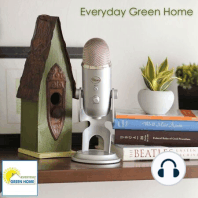35 min listen
Climate Crisis - Unintended Consequences
ratings:
Length:
34 minutes
Released:
Sep 8, 2021
Format:
Podcast episode
Description
The topic of unintended consequences is huge! Just thinking about it is enough to make my head spin! There are so many different aspects to consider in that regard, particularly when you think of unintended consequences in terms of their impact on the environment, climate change, and the day-to-day way we live our lives. I am Marla, the Green Home Coach. Today, I am excited to have my favorite co-host, Tony Pratte, joining me live in-studio to tackle the tremendous topic of unintended consequences. In this episode, Tony and I talk about how we need to think a little more about everything we do because there will always be some other effect or consequence to any of our actions. Leaping to conclusions So often, people leap to the conclusion that a certain solution is the only solution. I do not think that there is only one solution for anything. It will take many solutions I feel it will take many solutions to improve our health, safety, comfort, and this planet on which we live. A systemic approach Often, when looking for a solution, people fail to look any further than the next step. That is why we need to look at things systemically. A catchy phrase A catchy phrase or trending meme will not suspend the law of physics, the law of gravity, or the law of mathematics. Just because something sounds good, it does not mean that it is the right way to do it. Nor does it mean that there will be no consequences for that action. Introducing a biological organism into a different environment If we want to prevent something from getting out of balance, and we introduce a biological organism into an environment in which it is not naturally found, we are merely treating the symptom. To find a solution, we need to look at what caused the imbalance in the first place. Tradeoffs The departments of natural resources in the different states have programs that trade certain species to find out if they can exist in different environments. They do that for research purposes and also to increase biodiversity. An example An example of that happened in Missouri, where there was an overpopulation of white-tailed deer. A little more than ten years ago, some of the white-tailed deer got placed in a different location, and in return, the state of Missouri got given some armadillos. As a result, and as an unintended consequence, Missouri now has a growing population of armadillos. An unintended consequence with wolves We can see a similar unintended consequence where endangered wolves got reintroduced into places with a lot of ranching. Unintended consequences can also be good An example of a positive unintended consequence happened in Illinois when bald eagles got reintroduced. Illinois is one of the favorite migratory spots for the bald eagle to breed. So the unintended consequence is a lot of extra tourism in the area. Fully understanding the unintended consequences If people fully understood the unintended consequences of their proposals, they would be less likely to go forward with risky ventures. Out of control It has often happened that species brought in from other places to solve short-term problems have blossomed out of control in a new location. That unintended consequence is that the artificially introduced species then has to be controlled. Native plants It is always best to use native plants for your landscaping to avoid using extra resources to keep your plants alive. Building science Everything you do to protect yourself from the environment has a tradeoff. Building science looks at everything from a systemic perspective. It helps to control the tradeoffs and minimize the things that you do not want to happen. Building tighter homes In the 1970s, we started building tighter homes to save energy. However, we did that without considering what we were putting into our homes. The unintended consequences emerged about fifteen years later with mold issues in those homes and a generation of kids with more asthma cases than had ever been se
Released:
Sep 8, 2021
Format:
Podcast episode
Titles in the series (100)
Eating for Health - Ours and the World with Hannah Levbarg: You can make a bigger difference than you think to the environment by making small changes to what’s on your plate. We’re talking about food today, and we have Hannah Levbarg joining us to talk about how to green your plate. Hannah will be... by Everyday Green Home
